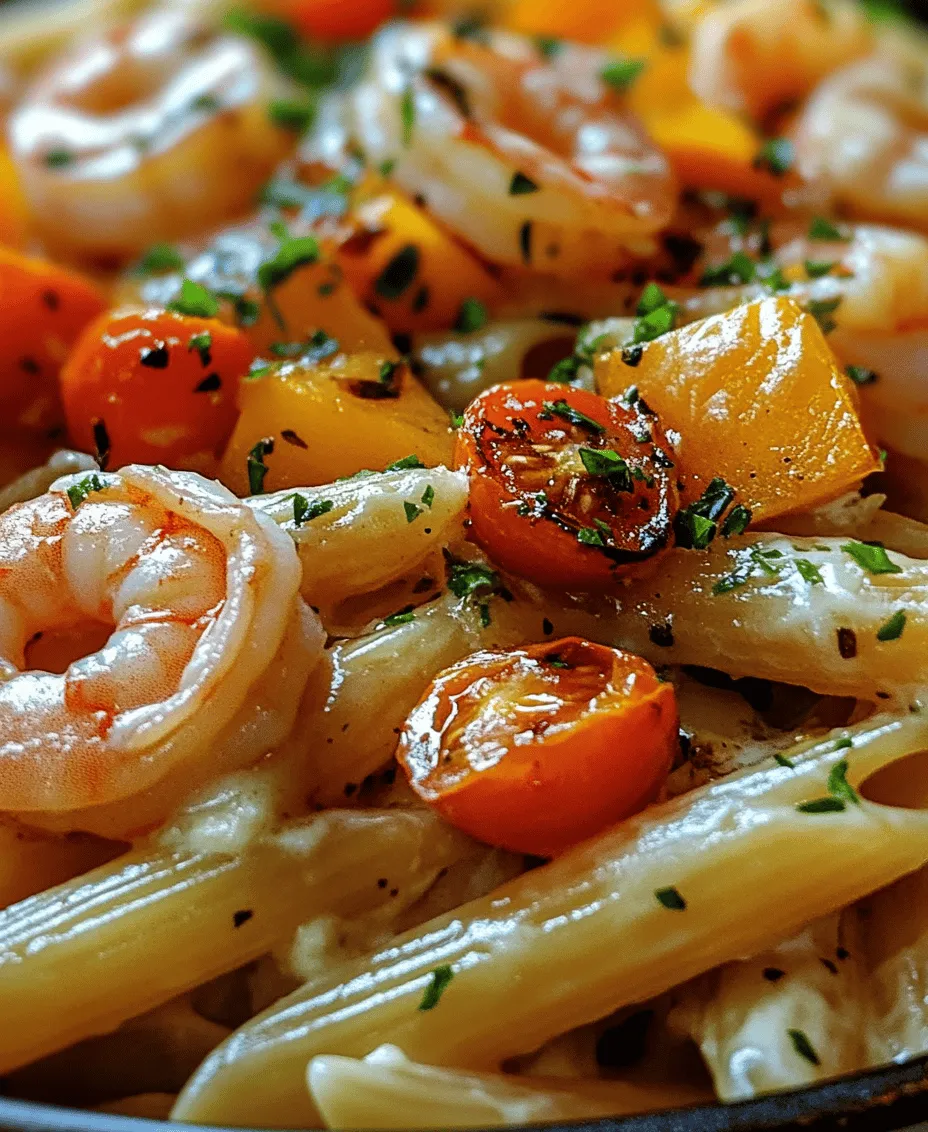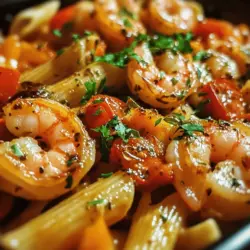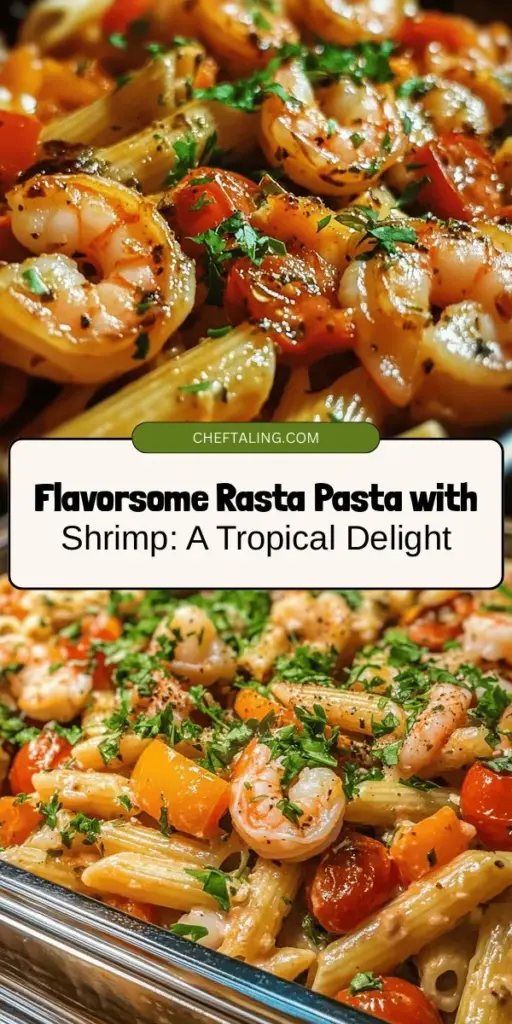Introduction
Rasta Pasta is an exciting culinary fusion that marries the vibrant flavors of Caribbean cuisine with the comforting tradition of Italian pasta dishes. This colorful dish is not only visually appealing but also packed with bold flavors that are sure to tantalize your taste buds. With its striking combination of bright bell peppers, fresh cherry tomatoes, and succulent shrimp, Rasta Pasta is perfect for both casual weeknight dinners and festive gatherings.
At the heart of this dish lies the creamy coconut milk, which creates a delightful contrast in texture and taste, complementing the spices and seasonings that define the Caribbean experience. Whether you’re a fan of spicy jerk seasoning or simply looking for a new way to enjoy pasta, Rasta Pasta with shrimp is a must-try.
In this article, we will explore the origins of Rasta Pasta, delve into the essential ingredients that make this dish unique, and guide you through the initial steps of preparing this delicious meal.
The Origins of Rasta Pasta
Rasta Pasta has its roots deeply embedded in Caribbean culture, particularly Jamaican cuisine. The dish is a beautiful representation of the island’s culinary diversity, showcasing how traditional flavors can be blended with international cooking techniques to create something truly unique.
The term “Rasta” refers to the Rastafarian movement, which originated in Jamaica in the 1930s. This cultural movement emphasizes a strong connection to African heritage, spirituality, and a deep appreciation for nature. Within this context, food plays a crucial role, with an emphasis on fresh ingredients and vibrant flavors.
Jerk seasoning, a hallmark of Jamaican cooking, is an integral part of Rasta Pasta. This spice blend typically includes ingredients like allspice, thyme, garlic, and Scotch bonnet peppers, creating a fiery and aromatic profile that elevates the dish. Coconut milk, another key ingredient, is widely used in Caribbean cooking for its rich and creamy texture. It adds a subtle sweetness and depth, balancing the heat of the jerk seasoning.
As a result, Rasta Pasta not only celebrates the flavors of the Caribbean but also pays homage to the cultural significance of its roots, making it a dish that is as meaningful as it is delicious.
Ingredients for Delicious Rasta Pasta with Shrimp
Now that we’ve explored the cultural background of Rasta Pasta, let’s take a closer look at the ingredients that make this dish sing. The combination of fresh produce, high-quality shrimp, and flavorful seasonings will create a memorable dining experience.
Main Ingredients Overview
Pasta
When it comes to choosing the right pasta for Rasta Pasta, both penne and fusilli are excellent options. Penne, with its tubular shape, holds onto the creamy sauce effectively, while the ridges of fusilli allow for a delightful mix of textures. Either choice will work beautifully, making it easy to enjoy every bite of this flavorful dish.
Shrimp
The star of the show in this recipe is undoubtedly the shrimp. Using fresh, high-quality shrimp ensures a tender and succulent texture that complements the pasta perfectly. When purchasing shrimp, look for those that are firm and have a mild ocean scent. It’s important to peel and devein the shrimp properly to remove the shell and the dark vein running along the back, which can be gritty.
Vegetables
A medley of vegetables adds not only flavor but also nutrition to Rasta Pasta. The following vegetables are essential for this dish:
- Onion: A sweet onion enhances the overall flavor base and adds depth.
- Bell Peppers: Brightly colored bell peppers (red, yellow, or green) not only provide a pop of color but also a crisp texture and sweetness.
- Garlic: Fresh garlic lends an aromatic quality that elevates the dish.
- Cherry Tomatoes: Their juicy sweetness bursts in your mouth, providing a delightful contrast to the creamy sauce.
Supporting Ingredients
In addition to the main components, several supporting ingredients play a vital role in creating the rich and unique flavor profile of Rasta Pasta:
- Olive Oil: Used for sautéing the vegetables and shrimp, olive oil adds a smooth richness and depth of flavor.
- Jerk Seasoning: This spice blend is the backbone of the dish, infusing it with aromatic heat and complexity.
- Coconut Milk: The creamy base that brings everything together, coconut milk adds a luscious texture and sweet undertones.
- Vegetable Broth: This helps to create a flavorful sauce while keeping the dish vegetarian-friendly.
- Lime Juice or Zest: A dash of lime juice or zest can brighten the dish, enhancing its overall freshness and flavor.
Preparation Steps for Rasta Pasta
Now that we have gathered all the ingredients, it’s time to dive into the preparation steps for Rasta Pasta with shrimp. This dish is not only easy to make but also allows for creativity in the kitchen. Follow these detailed steps to create a delicious and satisfying meal.
Cooking the Pasta
Begin by cooking the pasta to ensure it reaches the perfect al dente texture. Here’s how to do it right:
1. Boil Water: In a large pot, bring a generous amount of salted water to a rolling boil. The salt is essential, as it enhances the flavor of the pasta.
2. Add the Pasta: Once the water is boiling, add the pasta of your choice (penne or fusilli) and stir to prevent sticking. Follow the package instructions for cooking time, aiming for al dente, which means the pasta should be firm to the bite.
3. Drain and Set Aside: After cooking, reserve a cup of pasta water (this starchy water can help adjust the sauce’s consistency later). Drain the pasta in a colander and set it aside.
Sautéing the Vegetables
Next, it’s time to sauté the vegetables, which will add layers of flavor to your Rasta Pasta:
1. Heat the Oil: In a large skillet or frying pan, heat 2 tablespoons of olive oil over medium heat.
2. Add Onions: Once the oil is hot, add the chopped onion and sauté for about 2-3 minutes until it becomes translucent.
3. Incorporate Garlic: Add minced garlic to the pan and stir for an additional minute, allowing the garlic to become fragrant without burning.
4. Add Bell Peppers: Toss in the sliced bell peppers and continue to sauté for about 3-5 minutes until they soften but still retain some crunch.
5. Stir in Cherry Tomatoes: Finally, add the halved cherry tomatoes and cook for another 2-3 minutes until they just begin to burst, releasing their juices and flavor.
Cooking the Shrimp
Now it’s time to add the shrimp to the mix, ensuring they are cooked to perfection:
1. Season the Shrimp: In a bowl, toss the peeled and deveined shrimp with 1-2 tablespoons of jerk seasoning, ensuring they are evenly coated.
2. Cook the Shrimp: Push the sautéed vegetables to the side of the skillet and add the seasoned shrimp to the center. Cook for about 2-3 minutes on one side until they turn pink and opaque, then flip them and cook for an additional 1-2 minutes until fully cooked.
3. Combine Ingredients: Once the shrimp are cooked, stir them into the sautéed vegetables, allowing the flavors to meld together.
Stay tuned for the next part of this article, where we will complete the Rasta Pasta dish by adding the creamy sauce, combining it with the pasta, and sharing tips for achieving the best results. This dish is sure to impress your family and friends, bringing a taste of the Caribbean to your dining table!

Cooking shrimp can be a delicate process; the key is to avoid overcooking them to ensure they remain tender and juicy. Here’s how to perfectly cook shrimp for your Rasta Pasta.
Cooking Shrimp to Perfection
To achieve perfectly cooked shrimp, start by ensuring they are thawed if previously frozen. Rinse them under cold water and pat them dry with a paper towel. The ideal cooking time for shrimp is quick—typically, 2 to 3 minutes per side, depending on their size. Heat a skillet over medium-high heat and add a splash of oil. Once the oil is hot, add the shrimp in a single layer.
Cook the shrimp until they turn pink and opaque, which is a clear sign they are done. Remove them from the skillet immediately to prevent them from cooking further in the residual heat. Overcooked shrimp become rubbery and lose their delightful texture, so timing is crucial.
Creating the Creamy Sauce
The creamy sauce is the heart of Rasta Pasta, bringing together rich flavors that beautifully complement the shrimp. To create this sauce, you’ll need coconut milk, garlic, and your choice of herbs and spices. Begin by heating a tablespoon of oil in the same skillet used for the shrimp. Add minced garlic and sauté until fragrant, taking care not to burn it.
Next, pour in the coconut milk, stirring gently to combine it with the garlic. The coconut milk adds a creamy texture while imparting a subtle sweetness that balances the dish. Season with salt, pepper, and, most importantly, jerk seasoning. The jerk spice is what gives Rasta Pasta its signature flavor, so don’t be shy—add enough to suit your taste. Allow the sauce to simmer for about 5–7 minutes until it thickens slightly, stirring occasionally. If desired, you can add a squeeze of lime juice for a fresh finish.
Combining Pasta and Sauce
Once your sauce is ready, it’s time to bring everything together. Begin by adding the cooked pasta to the skillet with the sauce over medium heat. Toss the pasta gently, ensuring it is well-coated with the creamy sauce. If the sauce seems too thick, you can add a splash of pasta cooking water to help loosen it up.
Next, add the cooked shrimp, folding them into the pasta and sauce mixture. Make sure each piece of shrimp is enveloped in the creamy goodness. The goal is to have a harmonious blend of flavors and textures, so take your time to mix everything well. Allow the dish to heat through for a couple of minutes, letting the flavors meld beautifully.
Serving Suggestions for Rasta Pasta with Shrimp
Presentation can elevate any dish, and Rasta Pasta is no exception. When serving, consider garnishing with freshly chopped parsley or cilantro for a burst of color and freshness. A sprinkle of red pepper flakes can also add a nice visual touch and a hint of additional heat.
For side dishes, pair your Rasta Pasta with a fresh garden salad or roasted vegetables to complement the richness of the pasta. Another delightful pairing is garlic bread, perfect for soaking up any leftover sauce. You can also serve the dish with lime wedges on the side, allowing guests to add a splash of citrus for added brightness.
Nutritional Benefits of Rasta Pasta
Rasta Pasta with shrimp is not just delicious; it also offers a range of nutritional benefits. The dish is primarily made up of pasta, shrimp, and a variety of vegetables, making it a balanced meal.
- Shrimp is an excellent source of high-quality protein, low in calories and fat, while also providing essential nutrients such as selenium, vitamin B12, and iodine.
- Coconut milk contributes healthy fats, particularly medium-chain triglycerides (MCTs), which are known to support energy levels and metabolism.
- Vegetables such as bell peppers, onions, and spinach add vitamins A and C, potassium, and fiber, increasing the dish’s overall nutrient density.
Health Benefits of Ingredients
Each component of Rasta Pasta contributes to its health profile. Shrimp is particularly beneficial for muscle growth and recovery due to its high protein content. The omega-3 fatty acids found in shrimp may also support heart health.
Coconut milk, while rich in calories, offers healthy fats that can be beneficial for brain health and energy. The inclusion of colorful vegetables not only adds flavor and texture but also ensures you’re getting a variety of vitamins and minerals.
Balancing Flavors and Nutrition
Rasta Pasta with shrimp can seamlessly fit into a balanced diet. The combination of protein from shrimp, healthy fats from coconut milk, and carbohydrates from pasta creates a satisfying meal. The presence of vegetables ensures that you are also consuming dietary fiber, which aids digestion.
By controlling portion sizes and balancing the ingredients, this dish can be enjoyed as part of a healthy eating plan. For those looking to maintain a balanced diet, consider serving the pasta alongside a generous portion of vegetables or a salad to boost the nutritional content and volume of your meal without excessive calories.
Variations of Rasta Pasta
While the classic Rasta Pasta with shrimp is a crowd-pleaser, there are several variations to cater to different dietary preferences and tastes.
Vegetarian Variations
To create a vegetarian version of Rasta Pasta, simply substitute shrimp with plant-based proteins. Tofu, when marinated and sautéed, can mimic the texture of shrimp while absorbing the flavors of the dish. Alternatively, chickpeas can be added for a boost of protein and fiber. Ensure you sauté the tofu until golden brown for added flavor and texture.
You can also introduce more vegetables to the dish, such as zucchini, mushrooms, or eggplant, to enhance the flavor and nutrition profile.
Spicy Options
For those who enjoy a kick of heat, there are several ways to spice up your Rasta Pasta. Adjust the amount of jerk seasoning to your liking, or add fresh chopped chili peppers directly into the sauce while it simmers. You can also incorporate a dash of hot sauce for an extra punch. If you prefer, consider garnishing with sliced jalapeños or habaneros for a fresh heat that complements the creamy sauce.
Conclusion
Rasta Pasta with shrimp is a vibrant and flavorful dish that embodies a fusion of culinary cultures, making it perfect for various occasions—from weeknight dinners to special gatherings. Its versatility allows for numerous adaptations, ensuring it can cater to diverse palates and dietary needs.
The joy of cooking this dish lies in the blend of flavors, the beautiful presentation, and the satisfaction of creating a meal that’s both comforting and nutritious. As you explore this recipe, don’t hesitate to make it your own by experimenting with different ingredients and flavors. Enjoy the cooking process, and most importantly, savor each delicious bite of your homemade Rasta Pasta with shrimp.


